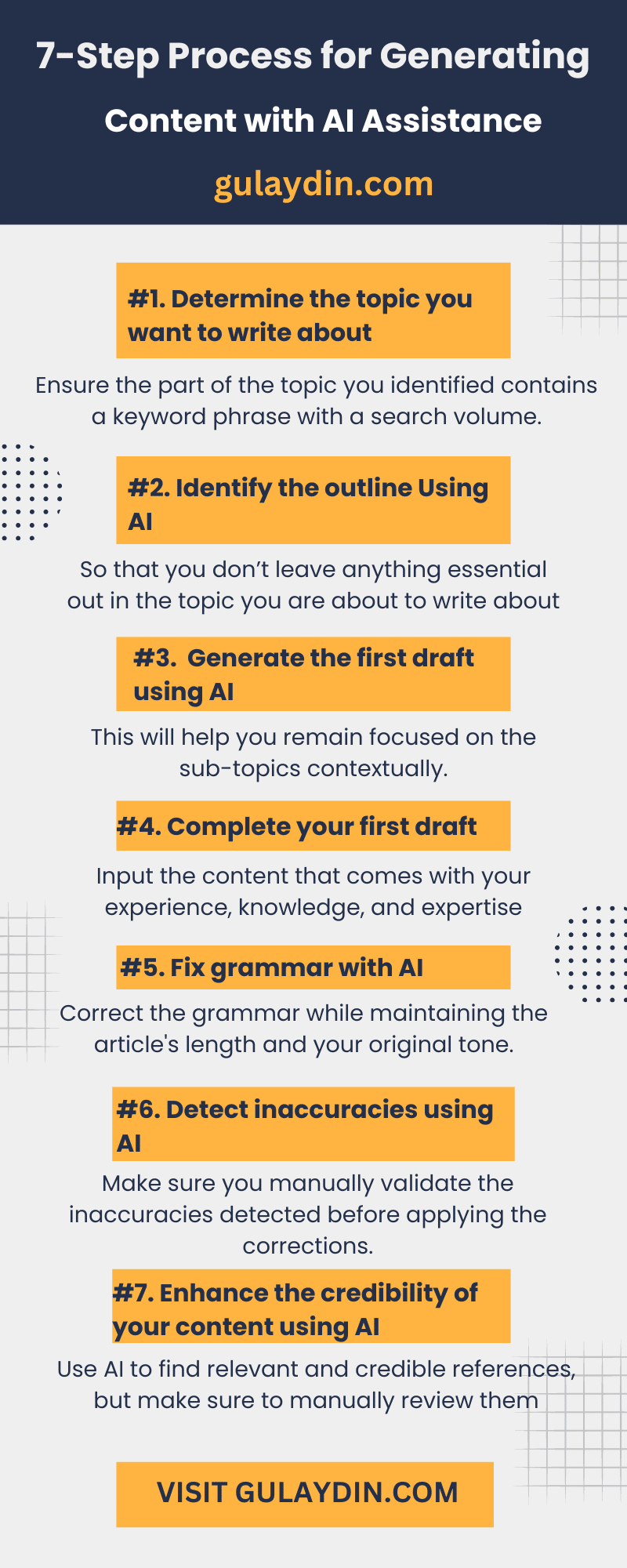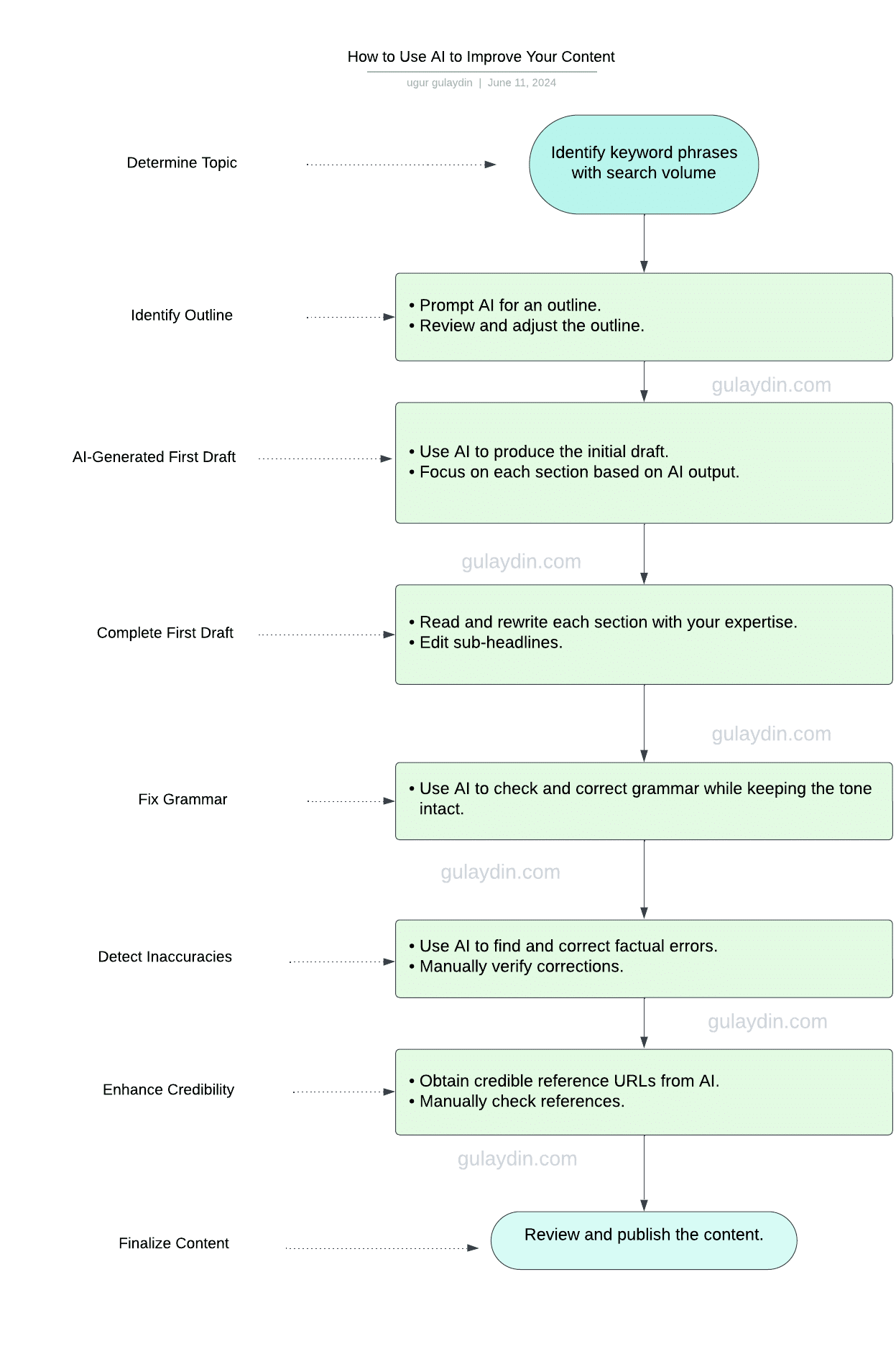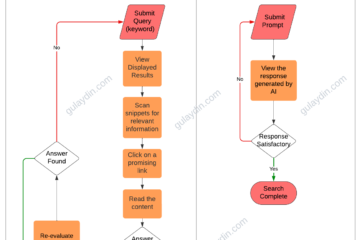I’ve seen many talented professionals shy away from sharing their insights just because they want to avoid technical editorial tasks such as grammar, outlines, and fact-checking. When it comes to using AI for generating content, the biggest challenge authors face is the NLP pattern. Overutilizing AI without a clear process often results in “AI-generated content” rather than “content generated with AI assistance.
There are many ways to apply AI assistance when producing content, but not all methods yield the same results. In this article, I will show you the process for correctly and consciously using AI to generate authentic content.
Understanding How AI Processes Information
Data Collection: Gathering data points tailored to your specific search (prompt) intent.
Data Processing: Filtering out inaccurate or irrelevant data and transforming text into numerical values.
Model Training: Making predictions based on your inputs (prompts) and producing outputs (labels).
Once the above processing is complete, ChatGPT employs its browsing capabilities for paid users to add references for each claim. Do you see where this is going? A near-perfect answer (search result) for each prompt (keyword) gives you the reference links so you can verify the result you see. Indeed, SEO is becoming obsolete, and Google now has more significant concerns.
Transitioning Existing Website SEO for AI – How to Adapt Your Website to AI

Before you start, if you aim to generate articles from scratch within a few hours, you might have misunderstood how search engines approach AI. The best use of AI when generating your content is to have it handle the tasks so that you can focus on delivering your expertise on the topic rather than technical-editorial tasks. Take this article, for example. Producing this article would have taken me a few weeks, but with AI assistance, I was able to start and finish in four days.
I wouldn’t call myself a “prompt engineer,” but I’ve spent considerable time testing prompts for SEO. Search engines don’t require publishers to avoid AI. Google’s stance can be summarized as follows:
So, how can one utilize AI assistance in content production?
For New Articles
“Use AI assistance when planning your content, but please do not publish content that AI generates.”
Confusing?
Those who believe Google won’t detect AI-generated content are wasting their time. Google employs NLP algorithms capable of distinguishing between AI-generated and human-generated content.
Prompts are crucial. Depending on its use, AI is just a tool that can be your greatest asset or your downfall. AI works on a simple principle of input (prompt) and output. Thus, the input you provide largely determines the output.
7-Step Process for Generating Content with AI Assistance
- Determine the topic you want to write about: Make sure the part of the topic you identified contains a keyword phrase with a search volume.
- Identify the outline: Go to AI and enter the following prompt:
Provide me with an outline for [topic here].
This step will ensure that you don’t leave anything essential out in the topic you are about to write about. No matter how sure I am before I go through this step, I almost always have these “aha” moments when I see sub-headlines provided by the AI. Review the outline. The outline provided by AI mostly has a proper structure and logical flow that will keep your thoughts organized when writing. If you are an expert in the topic (which you should be), you will probably make some changes and additions. - AI Generated First Draft: Use the following prompt:
Generate an article for this outline.
Most mistakes are made in this step. Once you have the article produced by AI, it may be tempting to be influenced by it. But remember, although AI processes this output by gathering several data points and processing, it’s still “AI-generated” content that is sourced by other publications. - Complete your first draft: Use the produced content in step 3 to maintain your focus for each section. Read each section carefully to understand what’s covered. This will help you remain focused on the sub-topics contextually. Delete the section you’ve read, and input the content that comes with your experience, knowledge, and expertise. I also recommend editing the sub-headlines to avoid the NLP pattern.
- Fixing Grammar: Once you finalize the first draft, you are now ready to check grammar. I tested the prompt below on over 150 articles:
I produced the content below using my knowledge and expertise. Fix the grammar, maintain the article length, and keep my tone intact. Provide the output with the original and corrected parts.
- Detecting Inaccuracies: Generative AI may help fact checking your content but never solely rely on the AI responses when fact checking. Always manually check the corrections from the original sources. Use the following prompt:
Identify factual inaccuracies in the text provided and correct them. Only provide direct replacements for incorrect information ready for direct use; do not include clarifications, contextual expansions, or enhancements. List each inaccuracy alongside its concise correction. Preserve the original tone and maintain the word count: [paste your content].
This prompt will produce an output showing your original inaccuracies and the corrected versions beneath them. You now have an accurate first draft. - Enhancing Credibility of Your Content: Continue your session with AI to enhance the credibility of your article’s claims by copying the corrected sections and submitting this prompt:
Provide me with credible reference URLs for the parts you corrected. Make sure to manually check the content reference links provided by AI, as they make mistakes more often than one would think. If your articles fall into the YMYL category, following this prompt will result in a factually solid article.
You might wonder, “Why not combine all the prompts and do this simultaneously?” The reason is that I prefer AI to correct me rather than produce the content for me. With this step-by-step process, you grant AI minimal autonomy to add NLP patterns to your article while also giving yourself a chance to check every output to remain authentic. Remember, you aim to be original and human-written, but get AI assistance to speed up the production, accuracy, and grammatical correctness of your content.
See Also: How to Optimize Your Content for AI
How About Fixing or Improving Existing Articles?
I approach existing articles differently. You want to be careful about what AI fixes or updates you make to avoid piling up your website with AI patterns. The importance of accuracy trumps authenticity for articles written purely for instructions, such as how-to and recipe articles. Of course, it’s better to have both, but inaccurate steps are why search engines ignore your articles:
Review the provided article text for accuracy and make any necessary corrections to ensure factual reliability. Correct any grammatical errors you identify. It’s crucial to retain the original structure and detailed content of the article as much as possible. Please aim to maintain or closely match the original word count to avoid creating thin content issues, ensuring the revised text is enriched and comprehensive. The HTML source code should remain unchanged.
For articles that are not purely written for instructions:
Fact-check and give me replacement text under each part that needs correction. Provide the original parts you correct and their replacements:
Fact checking tables: Export your tables in Excel -> go to Excel version of GPT -> Drag your table to AI chatbox and use the following prompt:
Replace inaccurate cells with correct ones and provide me with a summary of the changes you make.
If you have an HTML table, you can simply copy and paste the table’s HTML and use the following prompt:
Replace inaccurate cells with correct ones and provide me with a summary of the changes you make.
Pro Tip for Using AI Assistance to Improve Your Content
#1. Converting Your Articles into a Workflow
You no longer have to spend hours planning and creating workflows from scratch to enrich your content. AI can understand and convert your existing article into a workflow and give you specific instructions on how to implement it rapidly. Here is the prompt:
Convert the following article into a detailed workflow diagram. Include the specific names of the shapes for each object as used in Lucidchart (e.g., Terminator, Process, Decision). Also, provide detailed instructions for each step in the workflow and ensure logical improvements where necessary: [insert URL or text]
I experimented with it for this article and here is the result:

#2. Converting your articles into video scripts
Your articles can be video scripts in a matter of seconds. If you want something basic, you can simply use:
Convert this article into a video [insert your article text here]
As you get familiar with the basics, you can instruct AI to convert your articles into specific outlines such as:
Convert the following article into a video script and include:
- Grab audience attention
- Present key points in a logical flow
- Call to action
Take a Different Approach When Deciding the Topics You Want to Write About
The SEO game hasn’t just evolved; it has been fundamentally transformed. Bloggers who have built their content strategy around making complex facts digestible must acknowledge that even basic AI tools now perform this function. In the broader context, blogs are generally categorized into YMYL (Your Money Your Life) and Non-YMYL topics. Google defines YMYL content as topics that could significantly impact the health, financial stability, or safety of people, or the welfare or well-being of society.
If your blog is YMYL, it likely discusses topics based on facts from government and university sites. You produce content that is easy to read, well-structured, and thoroughly referenced. So, what’s the issue with being thorough? Nothing, except that AI can accomplish this in seconds and often more efficiently by delivering the facts from original references with decent readability output.
I believe focusing your content around your own validated experience will have the most rewarding results. When you create content powered by your own knowledge and expertise, you actually provide added value to the worldwide web.

0 Comments